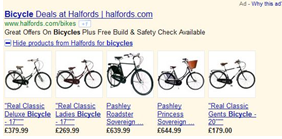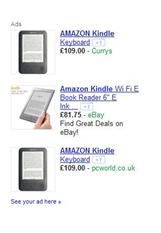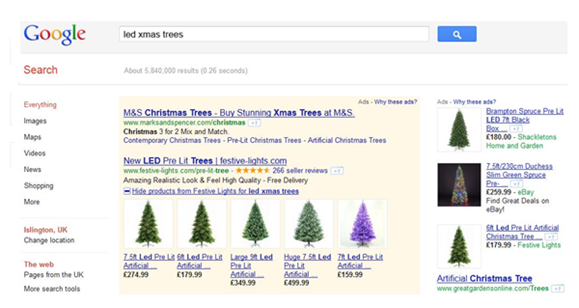After a lengthy period of beta testing, Google has made Product Listing Ads widely available to advertisers in the UK. This new product ad format compliments the product ad extensions (figure 1) already available in AdWords. This new addition is likely to have a significant impact on the look, feel and dynamic of the search engine results pages (SERPs). Currently, few seem to be making use of this new functionality. However, in the run up to the festive season and beyond, advertisers in the retail space should wise up and get in on the game as quickly as they can.

Fig.1 Product ad extensions
Google product ads are currently available in two formats:
- Product ad extensions - an expandable link within the ad to reveal related products
- Product ad listings - these new keywordless ads match content within your Google Merchant Centre feed to the users' search query. They currently appear at the top right side of the page. The product listing ad format has been available in the US since November 2010 and Google claims "users are twice as likely to click on Product Listing Ads than on text ads in the same location".

Fig.2 Product ad listings
The Impact
Whilst there is nothing surprising about Google's claim, it is a statement that should raise alarm with competing advertisers in this space - enter Quality Score. Although many factors of the notorious Google Quality Score are shrouded in mystery, it is a well known fact that one of the primary determinants for the calculation of this metric is Click-thru Rate (CTR). If CTR's are doubling for product ads, what impact will this have on the CTR of the competing ads on the SERP's? There will inevitably be a significant decrease for the standard text ads, which might in theory, cause a decrease in quality score for advertisers not employing product ads. Some advertisers might see this as an unfair penalisation for running the traditional text ad format; unless Google is factoring the presence of product ads into the quality score calculation. My view is that it is, however, Google has given no official indication this is the case.
A Sign of Things to Come?
The SERP displayed in figure 3 serves as a possible insight into the future of the Google ad space. From what in years gone by was a static, text-heavy beast, the addition of these new formats make the current SERP a far more engaging and interactive place. The combination of expandable links, product descriptions, product images and price points give the modern day SERP the feel of an actual web page. Through its testing phase, Google has found users are engaging far more with images than with text, so this move has the feel of natural progression.
Google will claim this progression benefits both the user and advertiser alike; however the true motive behind this evolution is obvious. Increased user interaction with the sponsored listings bears a positive correlation with Google's bottom line.

Fig.3 SERP displaying product ad extensions and listings
Currently there appear to be just a small number of advertisers utilising this additional functionality. I expect that once those who are late to the party begin to take notice of the effect on their CTR's and the knock-on effect on sales volumes, they will have little choice but to sit up and take notice.
Soon these product ads will become commonplace on the SERPs. How will Google attempt to accommodate the demand from advertisers to have product ads appearing? If they have such a significant effect on ad performance, will this stimulate a rush to increase Cost per Click (CPC) bids to hit those top positions?
These are questions that will be answered in the coming months as these ad formats mature. For the moment, advertisers in the retail space should endeavour to get in on the game as quickly as possible to capitalise on the peak trading season in the run up to Christmas.



